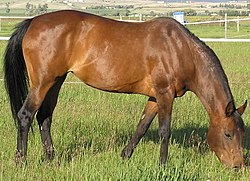
Back كميت (خيل) Arabic Pelatge bai Catalan Tsévó'névóvâtse CHY Hnědák (kůň) Czech Brauner (Pferd) German Beja Esperanto Caballo castaño Spanish کهر Persian Ruunikko Finnish Bai (cheval) French
| Bay | |
|---|---|
 A bay mare | |
| Variants | Bright reddish-brown to dark shades probably influenced by sooty or seal brown, points may be restricted in "wild bay" pattern |
| Genotype | |
| Base color | Black (E) |
| Modifying genes | agouti gene (A) |
| Description | reddish-brown body coat with black point coloration |
| Phenotype | |
| Body | Reddish-Brown |
| Head and Legs | Black |
| Mane and tail | Black |
| Skin | Black |
| Eyes | Brown, unless modified by another gene |
| Other notes | Black ear edges |
Bay is a hair coat color of horses, characterized by a reddish-brown or brown body color with a black point coloration on the mane, tail, ear edges, and lower legs. Bay is one of the most common coat colors in many horse breeds.
The black areas of a bay horse's hair coat are called "black points", and without them, a horse is not a bay horse. Black points may sometimes be covered by white markings; however such markings do not alter a horse's classification as "bay". Bay horses have dark skin – except under white markings, where the skin is pink. Genetically, bay occurs when a horse carries both at least one dominant Agouti gene and at least one dominant Extension gene. While the basic genetics that create bay coloring are fairly simple, the genes themselves and the mechanisms that cause shade variations within the bay family are quite complex and, at times, disputed. The genetics of dark shades of bay are still under study. The genetic mechanism that produces seal brown has yet to be isolated, however most seal brown horses appear to have the genotype EE Aa, which could play a part. Sooty genetics also appear to progressively darken some horses' coats as they age, and that genetic mechanism is yet to be fully understood.
The addition of dilution genes or various spotting pattern genes create many additional coat colors, although the underlying bay coat color genetics usually manifest by a warm-toned red, tan, or brownish body color and the appearance of black points.